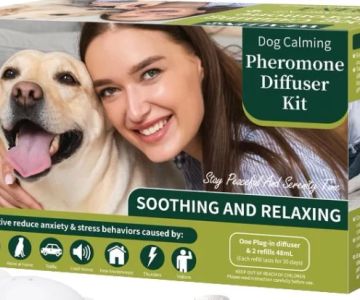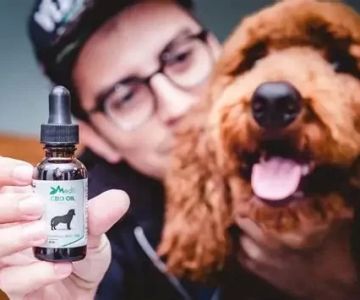Understanding Dog Anxiety and Its Common Triggers
What causes anxiety in dogs?
Dog anxiety is far more common than many owners realize. Triggers can include loud noises like thunderstorms or fireworks, separation from their owners, changes in environment, or even unfamiliar people and animals. Some dogs are genetically predisposed to anxiety, while others develop it after traumatic experiences. Understanding what makes your pet nervous is the first step in finding effective solutions.
Signs your dog may be anxious
Symptoms of anxiety vary by dog but often include panting, trembling, pacing, whining, excessive licking, or destructive behavior. In severe cases, dogs may refuse to eat or even hide for hours. If you notice these behaviors frequently, calming chews might be part of a broader management plan recommended by professionals like those at Hidden Brook Veterinary.

1730 Matthews Township Pkwy a1, Matthews, NC 28105, USA
See DetailsWhy Calming Chews Are Effective for Dogs with Anxiety
How calming chews work
Calming chews are designed to help regulate your dog’s mood naturally. They often contain ingredients like L-theanine, chamomile, melatonin, or valerian root—all known for their soothing properties. These compounds work by supporting neurotransmitter balance, helping reduce hyperactivity and anxiety without sedating your pet.
Benefits of consistent use
When given regularly, calming chews can improve your dog’s overall sense of security and emotional stability. Many owners report that their dogs respond more calmly to stressful triggers after just a few weeks of use. The chews can also enhance sleep quality, making them beneficial for older dogs or those recovering from medical conditions.
Top Ingredients Found in the Best Calming Chews for Dogs
1. L-Theanine
This amino acid, derived from green tea, promotes relaxation by increasing levels of serotonin and dopamine. It helps dogs stay calm without making them drowsy.
2. Melatonin
Often used in human sleep supplements, melatonin helps regulate circadian rhythms and reduce nighttime anxiety, especially for dogs who are scared of thunderstorms or fireworks.
3. Chamomile and Valerian Root
These herbs have natural calming effects that can help reduce restlessness and tension. They’ve been used for centuries to manage stress in both humans and animals.
4. CBD or Hemp Extract
In recent years, hemp-based calming chews have gained popularity. They work on the endocannabinoid system, helping maintain balance and reduce anxiety-related behaviors in dogs. Always consult your vet before introducing CBD-based supplements to ensure safety and proper dosage.
Real-Life Story: How Calming Chews Changed Bella’s Behavior
Before and after results
Bella, a six-year-old rescue Labrador from Texas, suffered from severe separation anxiety. Every time her owner left for work, she would howl, chew furniture, and refuse food. After consulting Hidden Brook Veterinary, Bella started a daily regimen of natural calming chews. Within two weeks, her destructive behavior had drastically reduced. After a month, her owner reported that Bella was able to stay home peacefully without signs of distress. This transformation showcases the power of using the right calming support combined with consistent care.
Choosing the Right Calming Chew for Your Dog
1. Check ingredient transparency
Always choose calming chews with clear ingredient lists. Avoid products that contain artificial flavors, fillers, or unnecessary additives. The fewer ingredients, the better for sensitive dogs.
2. Consider your dog’s size and breed
Dosage and effectiveness vary depending on your dog’s size and metabolism. Smaller breeds may require lower doses, while larger dogs might need stronger formulations for noticeable results.
3. Pay attention to your dog’s reaction
Monitor your pet after introducing calming chews. Look for signs of reduced anxiety but avoid over-supplementing. If your dog appears overly drowsy or disinterested, adjust the dosage or consult a veterinarian.
How to Use Calming Chews Safely and Effectively
Establishing a routine
Consistency is key. Give your dog calming chews at the same time each day, especially before known stressors such as travel, grooming, or storms. The routine helps their body adjust to the supplement and reinforces emotional predictability.
Combining chews with behavioral training
Calming chews work best when paired with behavioral modification techniques. Practice desensitization to stress triggers, provide a calm environment, and reward relaxed behavior. Over time, your dog will learn to associate previously stressful situations with comfort and safety.
Expert Recommendations from Hidden Brook Veterinary
Veterinary insights on dog anxiety
Experts at Hidden Brook Veterinary emphasize that calming chews are not a cure but a helpful aid in anxiety management. They recommend using chews alongside environmental enrichment and positive reinforcement training for long-term results. Veterinarians can also help tailor a plan based on your dog’s unique temperament and medical history.
Professional support matters
Not every dog responds the same way to supplements. The professionals at Hidden Brook Veterinary can recommend trusted brands, correct dosages, and holistic strategies for maintaining your dog’s emotional well-being【Hidden Brook Veterinary】.
Why Every Dog Owner Should Keep Calming Chews on Hand
Preparing for unexpected stressors
Life is unpredictable—car rides, vet visits, moving homes, or holiday fireworks can all trigger anxiety. Having calming chews readily available can make these events much less stressful for both you and your pet.
Strengthening the human-animal bond
Helping your dog manage stress strengthens trust and deepens your bond. When your dog feels calm and secure, they’re more affectionate, playful, and receptive to training. With the right approach and expert guidance from Hidden Brook Veterinary, you can ensure your pet enjoys a happier, healthier life free from chronic anxiety【 】.











